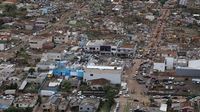On the night of November 7, 2025, the tranquil town of Rio Bonito do Iguaçu in Brazil’s southern Paraná state was transformed in less than a minute into a scene of devastation. A powerful tornado—described by many officials as unprecedented in the state’s history—ripped through the town, killing at least six people and injuring more than 750 others, according to local authorities and multiple news outlets including Reuters, CNN, and the Associated Press.
With winds that may have exceeded 250 kilometers per hour (155 mph), the tornado left a trail of destruction that affected about 90% of the town’s residences and commercial buildings. The event was so severe that, as CNN reported, Paraná Governor Ratinho Júnior called it an “unprecedented catastrophe in the history” of the state. The government quickly declared a state of public calamity, allowing for emergency measures and the mobilization of resources to aid the stricken population.
The tornado struck late on Friday, and its impact was felt almost immediately. Roofs were torn from homes, buildings were reduced to rubble, and vehicles were flipped like toys. Aerial photographs published by AFP and other agencies revealed the extent of the damage: scores of buildings without roofs, entire blocks flattened, and a landscape that more closely resembled a war zone than a peaceful Brazilian town. Fernando Schunig, head of the Paraná Civil Defence agency, told G1, “When these events hit an urban area, the damage is major. It is very lethal.”
Among the six confirmed fatalities were three men aged 49, 57, and 83, two women aged 47 and 14, all from Rio Bonito do Iguaçu, and a 53-year-old man from the nearby city of Guarapuava, as reported by the state government and CNN. At least one person remained missing as of November 9, 2025, with search and rescue operations continuing as families awaited news of their loved ones. The town, home to approximately 14,000 people, was left reeling in the aftermath, with about 1,000 residents displaced and many more left homeless.
Hospitals in the region were quickly overwhelmed by the influx of injured. Cinthia Kelly Somariva, director of a nearby hospital, described the chaos and sorrow of the night: “It was a very sad and intense night. There were lives lost.” At least 10 of the injured underwent surgery, and nine were reported to be in serious condition as of the weekend, according to health authorities and BNO News.
Some residents shared harrowing stories of survival. Gilberto Brecailo, whose mechanic shop was destroyed, said, “There’s not much we can do… All we have left are our clothes and our documents. My livelihood, my mechanic shop, is gone, and my son worked with me.” Marileia Chagas recounted being thrown against a structure by the wind but managing to hide under a bench until the storm passed. “When I came out, everything was destroyed. My daughter and my wheelchair-bound mother were inside. My father was inside too. I was devastated,” she said. “In two minutes, everything was on the ground; some people lost family, but we must thank God everyone is alive.”
The tornado’s fury was not limited to Rio Bonito do Iguaçu. Neighboring towns, including Guarapuava, also suffered from damaging winds, hail, and storms, though none experienced the same level of destruction. According to the severe weather research group PREVOTS, at least eight tornadoes were confirmed in the states of Paraná and Santa Catarina on November 7, with the Rio Bonito do Iguaçu tornado rated a preliminary F4 based on the extent of the damage and winds exceeding 200 miles per hour.
As the community grappled with the aftermath, federal and state authorities moved swiftly to provide relief. President Luiz Inácio Lula da Silva expressed his condolences and solidarity with the victims on social media, stating, “We will continue to assist the people of Paraná and provide all the help needed.” Members of his Cabinet, including Institutional Relations Minister Gleisi Hoffmann and acting Health Minister Adriano Massuda, announced plans to travel to the area to oversee emergency assistance and support reconstruction efforts. Emergency crews remained on the scene, assisting residents, clearing debris, and setting up shelters for displaced families. Food, hygiene products, tarps, mattresses, and other necessities were dispatched to aid those affected.
Governor Carlos Massa Ratinho Jr. declared three days of mourning beginning November 8, 2025, to honor the dead. The government’s declaration of a state of public calamity allowed for the rapid mobilization of resources and the request for federal support. Authorities also urged the public to avoid open areas and to remain alert for falling structures, trees, and power lines, given the risk of further accidents as cleanup operations continued.
The meteorological context for the tornado was complex. According to Climatempo and the Paraná Meteorology and Environmental Monitoring System (Simepar), the tornado was associated with a cold front and a larger cyclone system that brought wind gusts above 100 kilometers per hour to neighboring states such as Rio Grande do Sul, Santa Catarina, and São Paulo. Experts have noted that tornadoes, while uncommon in Brazil, occur most frequently in the country’s southern region, where warm, humid air from the tropics collides with cold air masses from Argentina. The destructive weather pattern hit as Brazil prepared to host the United Nations Climate Change Conference COP30 in Belem, drawing renewed attention to the potential impacts of climate change on severe weather events. Some meteorologists and climate scientists have pointed to the role of rising temperatures and increased atmospheric moisture in creating the instability and wind shear that give rise to such powerful storms.
As the town of Rio Bonito do Iguaçu begins the long process of recovery, the scars left by the tornado are both physical and emotional. For many, the loss of homes, businesses, and loved ones will not be easily forgotten. Yet amid the destruction, stories of survival and resilience have emerged, as residents and officials alike work together to rebuild what was lost and to support those most affected by the disaster.
The tornado of November 7, 2025, stands as a stark reminder of nature’s unpredictability and the importance of preparedness and community in the face of such calamities. As emergency crews continue their work and families mourn their losses, the people of Paraná are left to pick up the pieces, determined to restore their town and their lives.

